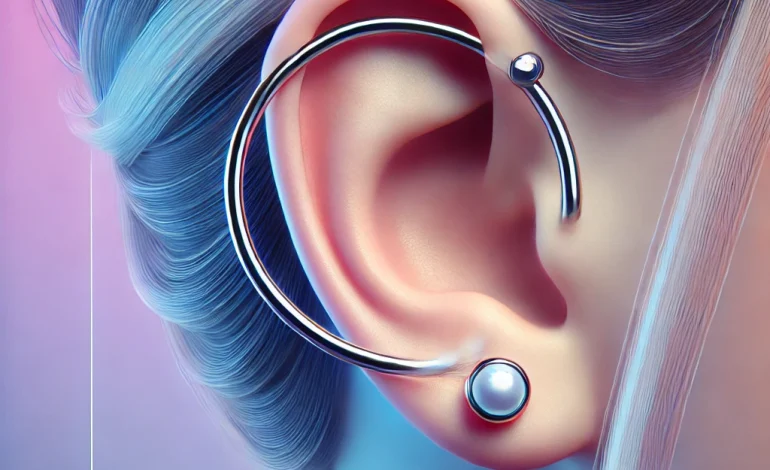Helix Piercing: A Complete Guide to Style and Care

Helix piercings have become increasingly popular over the years. They are stylish and customizable ways to express one’s individuality. Helix piercings are done on the upper cartilage of the ear. This piercing is versatile, and one can wear it with all possible styles of jewelry. You are planning to get a helix piercing or are just interest in what it entails, this is the complete guide.
What is a Helix Piercing?
A helix piercing is a cartilage piercing of the ear in the upper region. The term “helix” refers to the ear’s outer rim, and piercings at this location can be place anywhere along that line. There are standard helix piercings, forward helix piercings that come closer to the face, and double and triple helix piercings for those who wish to go all out.
Types of Helix Piercings
There are many different types of piercings on the helix cartilage; each type offers a distinct style and appeal from the other. These variations may form the basis of customized ear appearances. They may be combine with different piercings for a curated ear aesthetic.
Helix ear piercings can suit any kind of personal styling. This made them favorites of piercings veterans and newbies.
Standard Single Helix Piercing:
The standar helix ear piercings are the most widely accepte types of helix cartilage piercings. The discomfort from this piercing is relatively lesser than most but greater than the one from an earlobe piercing.
Double Helix Piercing:
Specifically, this refers to which type of piercings? The upper outer cartilage of the ear is pierce twice. Most people convert these into a stack by using helix studs or hoops, stacking them vertically.
Triple Helix Piercing:
If one has three piercings stacke upon each other in such a location, they are known as triple helix piercings. It is the same piercings, but more to refer to the number you have on the same ear.
Forward Helix Piercing:
However, most people refer to this piercing as an “anti-helix” piercing. It is find opposite the standar helix piercing. You can locate it on the cartilage at the outer rim of the front of the ear.
They usually also come as double or triple forward helix cartilage piercings, which hurt a little more than the standard one and take longer than average time to heal.
Triple Forward Helix Piercing:
This is when three piercings get done in the upper part of the ear, close to the face, just on top of the tragus. It is a common practice to wear small studs or maybe hoops in these particular piercings because it appear trendier.
Hidden Helix Piercing:
A hidden helix piercing is performed at the upper cartilage region of your ear, making it hidden and less perceptible than any regular helix ear piercings. It’s a very delicate option for people who would like to have a kind of different look.
Mid Helix Piercing:
A mid-helix piercing would differ from a regular helix piercing in the fact that the mid-helix piercing, compared to a normal helix piercing, is located right in the middle of the ear. The regular helix piercing would be positioned at the top of the ear.
Flat Piercing:
The flat helix piercing is positioned on the flat upper section next to standard helix piercings. Keeping in mind that the flat area has much thicker cartilage, healing will take more time in this place.
Why Choose a Helix Piercing?
Helix piercings have gained popularity among piercing lovers for several reasons:
- Creative Versatility: There is always a stud, a hoop, or a cuff to adorn the piercing, no matter what style you like.
- Low Commitment Usage: Unlike tattoos, if you don’t like it that day – or ever – the piercing could come out.
- Appealing Trend: They remain synonymous with the trending craze in the field of body modification.
The Piercing Process
Comprehending the procedure of piercing can be very helpful in a way that it gives you sheer comfort in confidence:
Consultation:
Select a credible piercing studio and schedule an appointment with a professional piercer. Make sure to discuss placement, jewelry options, and aftercare instructions.
Sterilization:
The piercer will clean and sterilize your ear to prevent the occurrence of infection.
Marking:
They will precisely mark the exact area for piercing to ensure its exact placement.
Piercing:
They will pierce through a sterilized hollow needle into the cartilage where a small hole is created. The duration for this to happen is quite short and relatively painless, but at times, you may feel a little pinch.
Jewelry Insertion:
A jewelry piece of your choice is inserted and the area cleaned once again.
Pain Level
Pain is always an individual’s experience. For instance, one might feel slightly more discomfort when undergoing the procedure, as cartilage is tougher than the tissue of an earlobe. Most people regard this kind of pain as minor and bearable.
Healing Time
Generally, helix piercings take between 6 and up to 12 months to completely heal, however, individual’s healing periods may vary according to their individual body types and aftercare practices. Initial healing may occur in mere months, but proper care should be continued to prevent complications from arising.
Aftercare Tips
Regular maintenance of your helix piercing should thus be carried on to avoid infection and support healing:
- Clean Daily: Wash twice daily with saline solutions, avoiding all forms of alcohol-based products.
- Avoid Touching: Touch the piercing very little and at the time of cleaning.
- Gentle: Sleep not on this part pierced, and avoid dragging clothing and hair over it.
- Patience: Healing takes considerable time, so be patient and follow the guidelines laid out by your piercer.
Common Issues and How to Handle Them
The types of problems related to healing from this helix piercing are swelling and redness, minor swelling, usually lasts up to initial healing. Cold compresses can be used to help relieve this mild discomfort. Infection signs include consistent pain, heat around the area, or discharge from the body. Visit a piercing artist or doctor with problems you experience for consultation. Lastly, bumps would sometimes surface, indicating that there could be some form of irritation or improper care. Changing hypoallergenic jewelry has also proven helpful sometimes.
Jewelry Options
Helix piercings can be fashioned with a wide variety of jewelry styles:
- Studs: Simple and elegant for every day.
- Hoops: Add some flair either with seamless or captive bead rings.
- Cuffs and Chains: Perfect for achieving a more dramatic look.
Conclusion
Helix piercing can give you a great way to express yourself while upping your style. With a qualified piercer and all the aftercare, not forgetting the time it takes for healing, this fantastic addition can be yours for as long as you want. Ready to make that bold statement? Go ahead and make an appointment with a reputable piercing studio, and begin your journey to a favorite new accessory.









